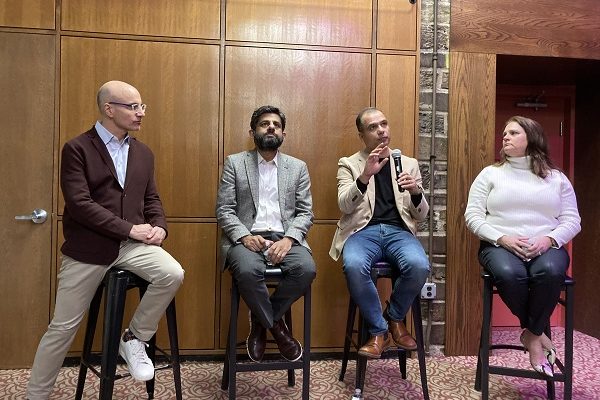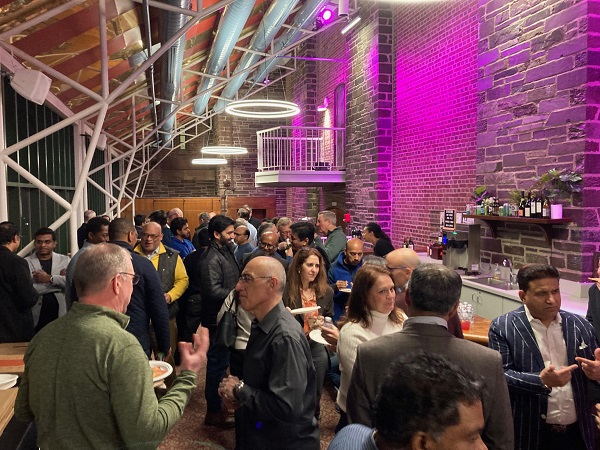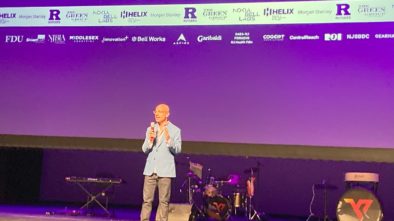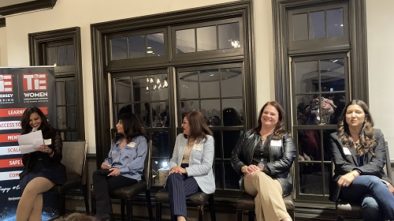AI In Healthcare Panelists Energize Princeton Tech Meetup
Approximately 100 people crowded into the lobby of the McCarter Theatre Center, in Princeton, to hear about “AI in Healthcare” at a recent Princeton Tech Meetup. There was plenty of networking going on, as meetup members both old and new traded information and talked about their businesses while consuming drinks and pizza.
Introducing the evening, organizer Venu Moola recapped the history of the Princeton Tech Meetup, which started at a bar in Princeton and moved to the Princeton Public Library, where it took up permanent residency. When COVID hit, the meetup went on a hiatus because “I didn’t want to host just another Zoom meeting,” said Moola. With about 7,500 members, Princeton Tech Meetup is now the largest tech meetup in New Jersey, he said, and will meet at both venues: the McCarter Theatre Center and Princeton Public Library. Moola said that 65 percent of those attending the event were newcomers to the group.
Moderating the discussion on artificial intelligence (AI) and healthcare was Jim Barrood, founder and CEO of Innovation+, a curated global community of 10,000 or more entrepreneurs and innovators. On the panel were: Kash Patel, executive vice president and chief digital information officer at Hackensack Meridian Health (Edison); Donna Conroy, cofounder and CEO of SciMar ONE (Allentown), a company with an AI- and generative AI-powered platform that removes inefficiencies to accelerate strategic drug development; and Rohit Vashisht, cofounder and CEO of WhizAI (Somerset), a generative AI-powered analytics platform purpose-built for life sciences and healthcare. The event was sponsored by Shay CPA (New York).
At the start of the discussion, Barrood asked about the growing fear of what generative AI will look like in the future, as it’s getting harder and harder to detect errors in the results of programs using the tool.
Vashisht told the group that they are lucky to be here at this time in history. “We are very fortunate people sitting in this room. We have seen so many technology transitions, which have actually completely changed our lives.” He was optimistic that the changes initiated by generative AI would be for the better.
Conroy added that she is not scared of the future, including the role of AI in medicine, as there will always be oversight by the Federal Drug Administration (FDA). Patel said that he was looking forward to seeing what AI can do in the future, especially in applications related to neurology and Alzheimer’s disease.
Networking at the Princeton Tech Meetup | Esther Surden
AI has the ability to improve efficiency and outcomes in healthcare and drug development by streamlining processes and identifying high-risk patients, the panelists agreed. However, when developing AI solutions, it is important to use responsible and ethical methods, to ensure safety, transparency and accountability. The panelists also agreed that there is a need for more diverse and inclusive data sets, to enable the training of AI models that can benefit all populations equally and avoid issues like bias.
Conroy told the audience that the pharmaceutical industry is entering a financial chasm. “A lot of drugs are coming off patent right now, and pharma is looking for the next set of drugs” that can help them remain profitable and reinvest in R&D. “I think every pharma company, from small to medium to large, is looking to AI to help offset those challenges and get new drugs to market or identify startup companies and develop them, to bring those new molecules in,” both to benefit patients and the industry as a whole.
She added that there is “a lot of interest in AI in clinical trials. … Everyone wants to identify where their patients are. I’ll give you an example: In lung cancer right now, there are almost 30 companies working on different molecules for lung cancer. There’s not enough patients to actually study all of those molecules.” So, there’s a race right now to find patients, and AI can help with that, she said.
Patel pointed out that 60 percent of hospital systems had an under-zero operating margin last year. Hospitals have been hoping that AI models will help them increase the value of their businesses and increase operating margins.
On the patient side, Hackensack is looking at AI to help predict risks for chronic diseases such as chronic kidney disease. The ability to detect kidney disease earlier may help keep patients off dialysis and out of the hospital, a worthy goal, he said. The hospital is inviting in young companies and allowing them to use their data sets — all securely — to see if they can come up with answers to some very tough questions around chronic diseases regarding both individuals and populations.
Vashisht pointed out that the low-hanging fruit in generative AI is productivity: specifically, the ability to find or develop answers in a matter of minutes, something that formerly took hours or even days. Conroy agreed, noting that a few years back a pharma company “asked us a very specific question. They wanted to know if hepatitis C patients moved on to liver cancer more quickly than those with fibrosis from other causes. We had to go through the data sets to figure that out. My analysts read over 5,000 journal articles” to figure out how many of them were useful to answer that question. “Only 30 to 32 of those publications helped answer that question. So, from 5,000 to 30. My best analyst was able to read and consume data in about 12 minutes an article, so think about how long it took to go through those 5,000. Today, we’ve trained our system to find the data that answers that specific question, and now we can answer that question in 10 minutes.”
Vashisht noted that he was more interested in what will be the “second and third order” uses of generative AI. When the web came along, email and buying books online were pretty much all you could do with it. However, 20 years later, it begat social media and Airbnb, and we are renting out houses and rooms online. No one knew that “the internet would have such a profound effect on our lives,” he said. “These are second- and third-order effects that result in trillions of dollars in GDP and productivity.” Generative AI will probably open up new opportunities like these in the next five to 10 years, he told the group.
The issue of data sets and bias animated the audience during the question-and-answer period. The panelist discussed the challenges around data sharing between healthcare organizations due to privacy regulations and the fact that private pharma and data companies are incentivized to keep their information proprietary. However, the panelists believe that there are opportunities to unlock more insights through data sharing. Sharing data sets can help eliminate biases that exist in current algorithms.
An audience member asked how generative AI can provide the reasoning behind its conclusions. Patel answered that it probably can’t. That’s why when the folks at Hackensack create anything based on generative AI, they use a team approach, with an eye towards governance. “We have ethics in the room, scientists in the room, DEI [diversity, equity and inclusion] in the room, audit in the room, and they’re asking exactly those questions. Where was the bias in our AI? And how are we ensuring that it isn’t excluding women of a certain age, for example? And, so, we actually test the model with that data, with the idea of bias up front.”
Conroy agreed, saying, “I think we all need to understand that there’s bias, right? And we have to understand how much bias there is in systems, right? And when you’re dealing with data that’s critical in nature, there is also bias in the data that you are training your model on. So I think we all are aware of it, and you need to stay aware of it. Because once you lose sight of that, that’s when you create problems.





